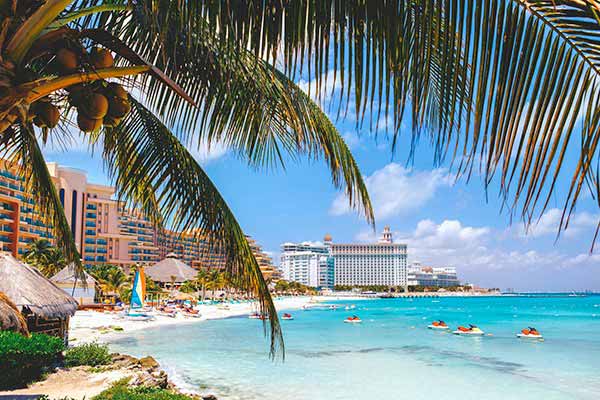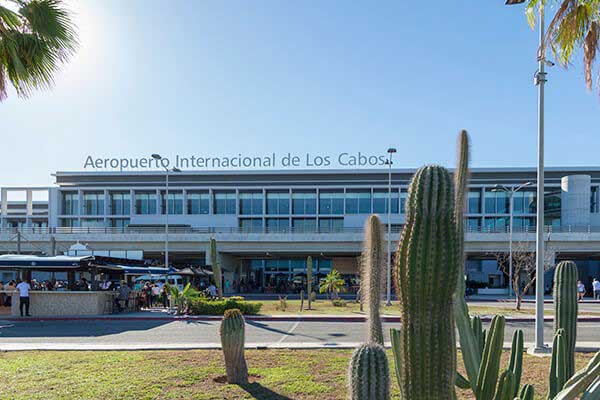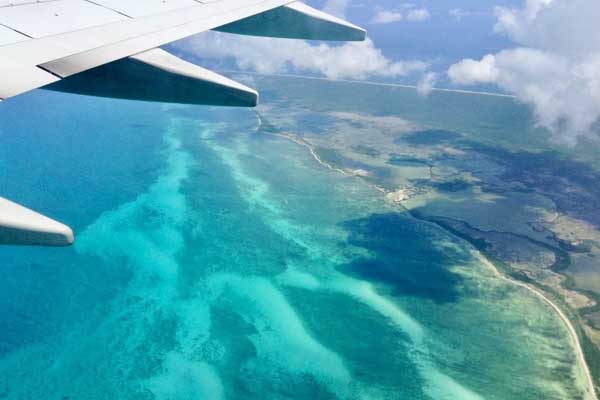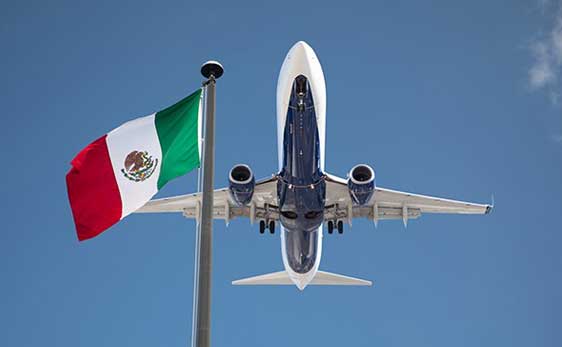Travel to Mexico - Updated Guide on Travel Restrictions and Travel Tips
By Bel Woodhouse
Mexico is full of wonder. Vibrant culture, colorful towns, and truly spectacular nature are why it is a top travel destination worldwide and why it’s consistently ranked in the top 5 in IL’s Annual Global Retirement Index. Anything and everything is possible in Mexico. From waking up in a luxurious treehouse and watching an active stratovolcano near Puebla to river rafting through majestic canyons in the Chiapas, Mexico has got something for everyone.
Each state and region within Mexico holds its own charms, with a lot to offer, see, and do. If you like being pampered, the all-inclusive packages along the Mexican Caribbean’s fine, white, sugary beaches in the postcard-perfect Riviera Maya offer every luxury. Or, if you prefer a more Indiana Jones-style adventure, exploring the richly red dunes of Pacula in Hidalgo is an out-of-the-way adventure to rave about.
And then there’s Mexico’s 132 Pueblos Magicós, or magic towns. They’ve become meccas for hundreds of thousands of tourists each year. As sites of historical, architectural, gastronomical, and cultural importance to the Mexican people, they are the highlights of each region, offering a true cultural experience.
All of these reasons (and more) are why travelers, adventurers, foodies, and those with an explorer’s soul flock to Mexico. But as your wanderlust takes you toward Mexico, there are a few things you need to know about travel in Mexico, particularly in light of the coronavirus pandemic.
Mexico Travel Restrictions

Is travel to Mexico restricted? Simply put, no. Requirements for travel to and within Mexico are very light and easy to abide by. Mexicans are welcoming and friendly, and tourism is a big part of almost every town’s survival. For this reason, Mexico was one of the first countries to fully reopen to travelers.
Mexico works on a traffic light system of COVID-19 restrictions, with maximum restrictions being red and minimum being green. All of Mexico is in a green or yellow (low restrictions) level except one state, Baja California. To see your destination’s restriction level, you can check this color-coded map for the entire country here.
Even the most popular destinations like Quintana Roo in the Mexican Caribbean—which includes the Riviera Maya region—and Mexico City are safe. It’s all green, so you can travel freely. This is because Mexico has administered more than 126 million doses of the COVID-19 vaccine. That equals about 97 doses per 100 people. Travel safety is one of the country’s top priorities.
Vaccines, Masks, Negative Tests
Most hotels and resorts will ask you to wear a mask at check in and in common areas. A negative COVID-19 test is not mandatory to enter Mexico, but it is wise to check your hotel’s website for any additional requirements they may have.
Staff will generally wear a mask at all times. Antibacterial gel is readily available and common areas like outdoor dining and pool areas are regularly sanitized for your protection.
When eating out in most cities, restaurants usually take your temperature upon arrival and offer antibacterial gel for your comfort and protection.
Travel to Mexico from the U.S.

The procedure for entering Mexico is easier than you may think—it was one of the first countries to reopen to travel, has no mandatory quarantine period, and doesn’t request proof of vaccination. Cruise ships and airlines may have their own requirements, so make sure to check their websites before travel.
Because Mexico was one of the first countries to reopen travel, their entry paperwork is readily available and the process is streamlined.
The good news is Mexico’s entry paperwork hasn’t changed. The two standard forms, Mexico Tourist Card and Customs Card, are the only forms you need to fill out.
The great news is that now they are available online. Filling them out before you go reduces stress, makes sure every family member gets a form, and avoids hassles at the airport.
Mexico Tourist Card
You can download and fill out your immigration requirements before you travel to Mexico. The Mexico Tourist Card instructions walk you through how to fill out the form.
Completing before you go is great because there isn’t always a flight attendant available to answer your questions. Plus, there is the added benefit of using Google Translate if you need clarification on anything.
Note: Your passport must have at least 180 days before expiry to apply online. If there are fewer than 180 days remaining, you have to fill out the form manually when handed to you on your flight or at the airport upon arrival.
Customs Requirements
The other mandatory form for entry into Mexico, the Customs Card, can also be filled out online and printed. Make sure you download and print both pages.
Airline Requirements
All airlines require the proper wearing of face masks. It has to fully cover your nose and mouth at all times unless eating or drinking. This is mandatory for every person and if you do not have a mask you will not be able to board your flight.
Travel from Mexico to the U.S.

Entry into the United States requires a negative COVID-19 test taken within three days before departure. It is highly recommended that you are fully vaccinated before travel. But if you are not, then a negative COVID test is required within 24 hours before entering the United States. You can read the full CDC (Centre for Disease Control) requirements here.
COVID Tests
COVID tests are available at most international airports in Mexico. They are very efficient with results available quickly—a lot of the time they’re also cheaper. For example, a COVID test in Cancun International Airport is less than $14, with results delivered straight away. Although it’s not ideal to leave it until the last minute, if you didn’t have a chance to get a COVID test before your day of departure make sure you arrive at the airport an hour earlier. This allows enough time to get the test and results before your flight. Especially because there may be quite a line up.
Prices range for COVID tests in Mexico depending on the testing site. To give you an idea of what you can expect to pay, a rapid antigen test at a CostaMed hospital is $40. The tests range in complexity and price. You can see the full scale of tests available and pricing here.
Mexican hotels, resorts, and pharmacies can all organize a COVID test for you before you leave (oftentimes with the doctor or tester coming to you to take stress out of the process). If you’d like a cheaper option, a lot of smaller hospitals and clinics also supply testing for less than major hospitals.
Streamlined Check in
Major U.S airlines send you a check in email a week before you fly. It lists all requirements that need to be met before entering the U.S. Apps like American Airlines’ preferred Verifly help breeze through an easy check in and ensure you meet all the CDC requirements.
It is also recommended to check the travel restrictions on your airline’s or cruise ships’ webpage.
If traveling by road, then proof of negative COVID test and vaccination are requested at the border along with the exit section of your Mexico Tourist Card.
Please note that once in the U.S., most restaurants will ask you to wear a mask and also have proof of a negative COVID test before they will seat you. If you do not have this proof you may be denied entry.

Get Your Free Mexico Report Here:
Learn more about Mexico and other countries in our daily postcard e-letter. Simply enter your email address below and we'll send you a free special report - Why Millions of Americans Are Moving to Mexico.
This special guide covers real estate, retirement and more in Mexico and is yours free when you sign up for our postcards below.
Travel Within Mexico

Half the fun of traveling within Mexico is exploring the many options of getting around, from private drivers to public transport; by plane, bus, or local collectivo. There are quite a few options and ways to get around depending on your travel style, comfort level, and budget.
By Road
Driving is a breeze in Mexico. Mexico has well maintained wide roads that are clearly marked so it’s easy to get from A to B. Be sure to check the car rental company has full insurance, not partial insurance. A GPS is also recommended if you are not familiar with the route. Depending on where you are driving, a lot of companies offer the option of leaving the car at a different destination so you can road trip.
If you’d prefer not to drive but kick back and enjoy the scenery, Mexico travel is famous for its big, luxurious buses. With excellent air conditioning, sanitization practices, and even reclining seats, you can lay back and watch a movie on those longer trips between cities. The buses, or autobuses in Spanish, are cheap, clean, and run on time. Just ask what the local bus line is and you can usually pre-book tickets online.
If you plan to stay closer to your destination, there are always taxis and smaller local transports called collectivos that get you around town, usually for under $1 (unless you are traveling further field, then it can be between $2 and $5).
For those that don’t want to drive at all, every town and city has local private drivers and shuttles that will take you from the airport to your destination. A quick Google search of the town you want to visit will give a long list of options and price ranges.
Public Transport
The most common public transport for longer trips is the autobus (bus), especially between cities. The bus line will vary depending on the region in Mexico. In Mexico’s number one visited destination, the Riviera Maya, and all of southern Mexico, it is the ADO bus line. They are reliable and very affordable.
To give you an example of what you would expect to pay, a four-hour bus ride from Playa del Carmen to the capital, Merida, will cost between $24 and $32, depending on the time of day and if there are additional stops. They run several times a day and you can choose your closest terminal here. Tickets can be bought at the terminal or online.
If you’re planning to stick around town then the smaller collectivo vans are the public transport for you. In some regions locals call them combis. It is the cheapest way to travel in Mexico. They are safe, and a lot of expats choose to zip around town in one of these mini vans to get where they need to go. Prices vary depending on distance but are usually about a quarter to a fifth of the price of a taxi.
Note: The price is fixed so whether you go one block or three miles the price will be the same.
By Air
A lot of major tourist destinations in Mexico have local flights and small plane services. Not only are they fun, but they are safe and a lot quicker for getting around. Prices will depend on the company, region, and flight time and popularity. They are available for charter or as a regular service.
During COVID these became more popular as they were private with fewer people. Unfortunately, the prices did go up, so be sure to get on the websites and look at pricing and schedules.
By Boat
If traveling in the Riviera Maya’s coastal area or island hopping then there are fast boat ferries to get around—the most popular being between Playa del Carmen and Cozumel. A round trip ticket is only $25 and valid for six months so you can use it any day you like. Or, just turn up and buy a ticket before you board.
Mexico to U.S. Travel: An Expats Travel Experience
By Bel Woodhouse

Traveling from Mexico to the U.S. is a lot more relaxed than I thought it would be. During the four flights, three airports, two countries, and two languages of my trip—from Cozumel to Palm Springs (via San Diego) to attend a writer’s retreat—everything ran like clockwork.
Leading up to the trip I’d heard rumors along the expat grapevine about the hassles and hardships of getting back to the United States. Complete with a couple of horror stories about all the hoops you have to jump through.
Quite frankly, it is all untrue.
To me, it felt like travel had returned to normal. In fact, flying from Cozumel to San Diego was like every other previous trip I’d taken to the U.S. And flying through Texas, stopping at Dallas Fort Worth Airport, the plane was full of happy travelers just like the pre-COVID trips of the past.
I arrived, hassle-free, at my destination. On time. Every time. For all four flights.
The biggest shock came when I was checking in for my early-morning return flight. It was fully automated for those passengers solely with carry-on luggage. If you did not have to check a bag, it was as simple as turning up and electronically checking in.
No one checked for a negative COVID test, although it is a mandatory requirement of the airlines. In this case, all that was required was for you to tick the box saying you have a negative COVID test, and off you go to security.
People went about their airport business as usual. Restaurants were full of happy diners, as were the cafés and snack stands. It appeared 100% normal, except everyone wore a mask.
If you are concerned about traveling to the U.S. from Mexico right now, there is no need to be. Everything appeared to have reverted to business as usual. The flight staff were friendly and kind. Everything is streamlined and, if anything, it is easier now than on my last pre-COVID trip to the U.S.
Just follow two mandatory rules and your trip will be smooth sailing. They are:
1. Always Wear a Mask.
Don’t play games. Wear it properly, fully covering your nose and mouth. No moving it down so your nose is exposed, or even further down so that you’re wearing it as a chinstrap. This is for your safety as much as other travelers.
Airlines are strict on this. You will be asked to wear your mask properly unless eating or drinking. If you refuse, you can be banned from flying with that airline again in the future. I saw it happen in Texas: A person didn’t want to wear a mask and was turned away, unable to board their flight.
2. Have Proof of Your Negative COVID Test.
This is mandatory. If you do not have proof of a negative test taken within 72 hours before your flight, you will not be allowed to board. The good news is they are cheap in Mexico.
I felt very lucky to live in Cozumel. A COVID test was only $26.
The process is quick and easy. I was seen as soon as I arrived and had the results in my hand, in English, in less than half an hour. They included both an English and Spanish verification of the negative test for my convenience at both Mexican and U.S. airports.
However, in the United States things were slightly different.
It was a lot more expensive to obtain a Rapid Antigen COVID test the day before my flight. At $129, it is five times the price. This price drops to $80 if you obtain the test two days prior to travel.
What impressed me was that the testing was so quick and easy. In fact, you don’t even need to get out of your car. They have drive-through COVID testing clinics set up in downtown San Diego. Just pull up and a nurse will take your swab while you remain sitting in the car.
Results are then emailed to you. It is quick and efficient and my results were sent within the hour. No stress.
Overall, traveling right now is quick, easy, and efficient. Just remember your mask and negative COVID test, then sit back and enjoy the trip.
Featured Image Copyright: ©Feverpitched/iStock

